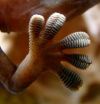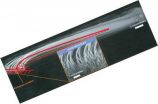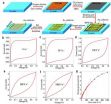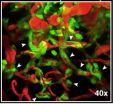(Press-News.org) CORVALLIS, Ore. – Researchers at Oregon State University have developed a model that explains how geckos, as well as spiders and some insects, can run up and down walls, cling to ceilings, and seemingly defy gravity with such effortless grace.
The solution, outlined today in the Journal of Applied Physics, is a remarkable mechanism in the toes of geckos that use tiny, branched hairs called "seta" that can instantly turn their stickiness on and off, and even "unstick" their feet without using any energy.
These extraordinary hairs contribute to the ability of geckos to run, evade predators, and protect its very life and survival. In essence, a gecko never has a bad hair day.
"These are really fascinating nanoscale systems and forces at work," said Alex Greaney, an assistant professor in the OSU College of Engineering. "It's based not just on the nature of the seta but the canted angles and flexibility they have, and ability to work under a wide range of loading conditions."
Even more compelling, Greaney said, is the minimal amount of energy expended in the whole process, as a gecko can race across a ceiling with millions of little hairy contact points on its feet turning sticky and non-sticky in a precisely integrated process. This "smart" adhesion system allows them to run at 20 body-lengths per second, and, hanging from a ceiling, the forces provided by the seta could actually support 50 times the body weight of the gecko.
In continued research the scientists want to find out more about this mechanism to recover stored energy, to see if more practical uses could be made of it – better adhesives, for instance, or robots that can use some of these principles for improved performance or use in extreme environments.
The adhesion system used by geckos and insects have literally been studied for thousands of years, Greaney said, and it was only in 2000 that experts proved they are taking advantage of a concept in physics called van der Waals forces, a type of weak intermolecular force.
Geckos' feet are, by default, non-sticky, but the stickiness can be activated by a small shear force to produce this surprisingly tough form of adhesion.
INFORMATION:
Digital images are available online to illustrate this story:
Gecko's foot: http://bit.ly/VcHdDg
Seta adhesion: http://bit.ly/1B9abEU
Greaney is traveling the week of Aug. 11 and most easily reached via email.
Scientists discover the miracle of how geckos move, cling to ceilings
2014-08-12
ELSE PRESS RELEASES FROM THIS DATE:
WSU researcher sees survival story in Antarctic fly's small genome
2014-08-12
PULLMAN, Wash.—Few animals can boast of being as tough as the Antarctic midge. Its larvae develop over not one but two Antarctic winters, losing nearly half their body mass each time. It endures high winds, salt, and intense ultraviolet radiation. As an adult, the midge gets by without wings and lives for only a week or so before starting its life cycle all over again.
And as Joanna Kelley has learned, it does this with the smallest insect genome sequenced so far.
"It's tiny," said Kelley, a Washington State University assistant professor, who recently sequenced and analyzed ...
Transgender relationships undermined by stigma
2014-08-12
PROVIDENCE, R.I. — Researchers who looked at the impact of discrimination, poverty and stigma on the mental health and relationship quality of transgender women and their male romantic partners found that social and economic marginalization not only takes a psychological toll on each person individually but also appears to undermine them as a couple.
It is difficult to be a transgender woman in the United States. Prior research has shown that they generally face high risks of depression, financial hardship, and discrimination, said study lead author Kristi Gamarel, a ...
Majority of Quebec children placed in out-of-home care are reunited with their family
2014-08-12
The majority of children in Quebec's youth protection system who are placed in out-of-home care (family foster care, or in a group or rehabilitation centre) are reunited with their "natural" families within 6 months, according to a study led by Professor Tonino Esposito of University of Montreal's School of Social Work. However, younger children, specifically those aged 2 to 5 years old at initial placement, have the lowest likelihood of returning to live with their natural families over time. "All placed children, irrespective of age, are less likely to return to live ...
Scared of crime? Good.
2014-08-12
EAST LANSING, Mich. -- In the past half-century, fear of crime in the United States has fueled "white flight" from big cities, become known as a quality of life issue and prompted scholars and law enforcement experts to address ways of reducing this fear.
But a study by a Michigan State University criminologist challenges this longstanding theory by arguing that a healthy fear of crime is, in fact, a good thing.
The study, published online in the journal Justice Quarterly, suggests adolescents who are more fearful of crime are less apt to become victims and offenders ...
ADHD, substance abuse and conduct disorder develop from the same neurocognitive deficits
2014-08-12
This news release is available in French. Researchers at the University of Montreal and CHU Sainte-Justine Research Centre have traced the origins of ADHD, substance abuse and conduct disorder, and found that they develop from the same neurocognitive deficits, which in turn explains why they often occur together. "Psychopathology exists on multiple continua of brain function. Some of these dimensions contribute to a multitude of problems, others contribute to specific problems. Together, they explain patterns of comorbidity such as why ADHD and conduct problems co-occur ...
Loss of eastern hemlock affects peak flows after extreme storm events
2014-08-12
The loss of eastern hemlock could affect water yield and storm flow from forest watersheds in the southern Appalachians, according to a new study by U.S. Forest Service scientists at the Coweeta Hydrologic Laboratory (Coweeta) located in Otto, North Carolina. The article was just published online in the journal Ecohydrology.
"Eastern hemlock trees have died throughout much of their range due to the hemlock woolly adelgid, an exotic invasive insect," said Steven Brantley, a post-doctoral researcher at Coweeta and lead author of the paper. "Though this insect has decimated ...
Graphene-based planar micro-supercapacitors for on-chip energy storage
2014-08-12
The rapid development of miniaturized portable electronic devices, such as micro-electromechanical systems, microrobots and implantable medical devices, has stimulated intense demand for micro-scale power sources. Although miniaturized micro-batteries that store energy by redox reactions provide the most frequently used micro-power source for current portable electronics on chip, their limited lifetime (hundreds or thousands of cycles) and low power density rule out applications that require high power over a short timeframe.
Micro-supercapacitors (MSCs) with a short ...
Researchers prove stability of wonder material silicene
2014-08-12
An international team of researchers has taken a significant step towards understanding the fundamental properties of the two-dimensional material silicene by showing that it can remain stable in the presence of oxygen.
In a study published today, 12 August, in IOP Publishing's journal 2D Materials, the researchers have shown that thick, multilayers of silicene can be isolated from its parent material silicon and remain intact when exposed to air for at least 24 hours.
It is the first time that such a feat has been achieved and will allow scientists to further probe ...
Prognosis of pneumonia: value of respiratory rate often overlooked
2014-08-12
Pneumonia – a severe lung infection – is the most common disease calling for hospital admission. More than one out of ten pneumonia patients die of the disease. Thus it is vital to accurately predict and closely monitor the clinical course. Here, measuring the respiratory rate – the number of breaths a person takes in a minute – provides valuable information. However, far too little use is still being made of this vital sign in clinical practice, as Richard Strauß and co-authors conclude in their recent study in Deutsches Ärzteblatt (Dtsch Arztebl Int 2014; 111: 503).
The ...
Hijacking the brain's blood supply: tumor discovery could aid treatment
2014-08-12
ANN ARBOR, Mich. — Dangerous brain tumors hijack the brain's existing blood supply throughout their progression, by growing only within narrow potential spaces between and along the brain's thousands of small blood vessels, new research shows for the first time.
The findings contradict the concept that brain tumors need to grow their own blood vessels to keep themselves growing – and help explain why drugs that aim to stop growth of the new blood vessels have failed in clinical trials to extend the lives of patients with the worst brain tumors.
In fact, trying to ...






